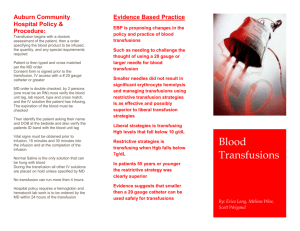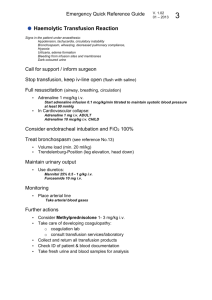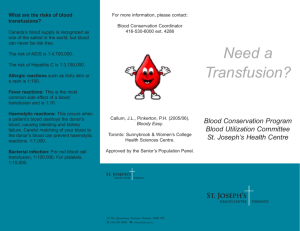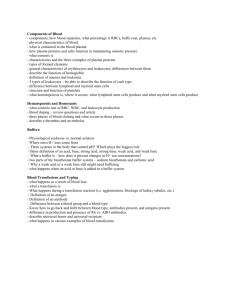check answers
advertisement
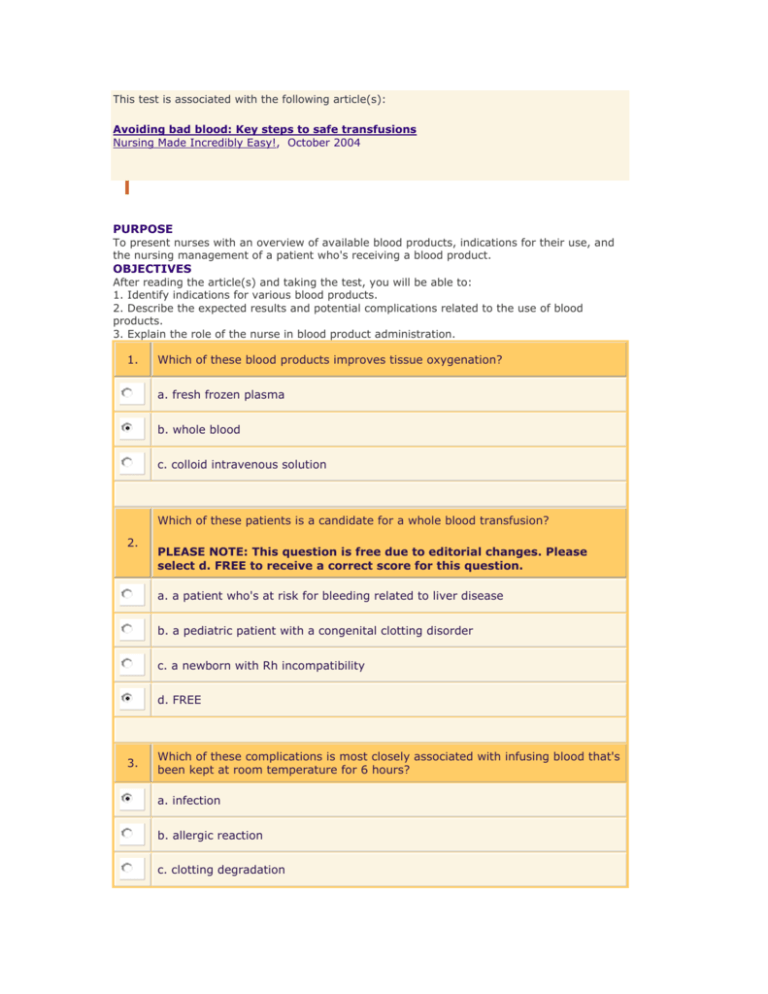
This test is associated with the following article(s): Avoiding bad blood: Key steps to safe transfusions Nursing Made Incredibly Easy!, October 2004 PURPOSE To present nurses with an overview of available blood products, indications for their use, and the nursing management of a patient who's receiving a blood product. OBJECTIVES After reading the article(s) and taking the test, you will be able to: 1. Identify indications for various blood products. 2. Describe the expected results and potential complications related to the use of blood products. 3. Explain the role of the nurse in blood product administration. 1. Which of these blood products improves tissue oxygenation? a. fresh frozen plasma b. whole blood c. colloid intravenous solution Which of these patients is a candidate for a whole blood transfusion? 2. PLEASE NOTE: This question is free due to editorial changes. Please select d. FREE to receive a correct score for this question. a. a patient who's at risk for bleeding related to liver disease b. a pediatric patient with a congenital clotting disorder c. a newborn with Rh incompatibility d. FREE 3. Which of these complications is most closely associated with infusing blood that's been kept at room temperature for 6 hours? a. infection b. allergic reaction c. clotting degradation 4. Which of these actions should you take when administering whole blood? a. Assign a staff member to remain with the patient during the entire transfusion. b. Keep the patient in a supine position. c. Auscultate the lungs for evidence of fluid overload. 5. A unit of whole blood is ordered for an elderly patient with congestive heart failure. Which of these infusion rates is appropriate? a. 4 ml/kg/hour b. 2 ml/kg/hour c. 1 ml/kg/hour 6. Which of these blood products is appropriate for a patient who's had repeated febrile reactions to transfusions? a. leukocyte-filtered PRBCs b. random donor packed cells c. frozen deglycerolized packed cells 7. A platelet infusion is indicated for a patient who a. will undergo coronary artery bypass graft surgery tomorrow because of severe coronary artery disease. b. has immune thrombocytopenic purpura with life-threatening bleeding. c. received several blood transfusions this week because of hemorrhage. 8. A patient who takes warfarin (Coumadin) for thrombophlebitis is hemorrhaging after severe trauma. Which of these infusions is appropriate? a. fresh frozen plasma b. random donor platelets c. a crystalloid infusion 9. When giving a whole blood transfusion, use a line containing a. Ringer's lactate solution. b. concentrated dextrose solution. c. 5% albumin solution. 10. How much will a patient's hemoglobin level typically increase after a unit of PRBCs is administered? a. 1 g/dl b. 2 g/dl c. 3 g/dl 11. Which of these is part of the baseline patient assessment before initiating a transfusion? a. capillary refill time b. bowel sounds c. vital signs 12. Which of these blood products should you return to the laboratory? a. a platelet infusion that's a light strawberry color b. RBCs that appear darker than the bag segments c. fresh frozen plasma that's a light green color 13. Check the vital signs of a patient who's receiving a transfusion before starting the transfusion and again a. in 15 minutes. b. in 30 minutes. c. in 1 hour. 14. Symptoms of acute hemolytic transfusion reaction (AHTR) include a. hypotension, hematuria, and chills. b. bradycardia, polyuria, and headache. c. pallor, dysuria, and abdominal pain. 15. Which of these actions is appropriate if a patient develops AHTR? a. Discontinue the blood immediately and hang 0.9% sodium chloride using new tubing. b. Change the infusion tubing and discard the old line. c. Clear the transfusion line with a dextrose solution, then restart the transfusion. Submit This Test



